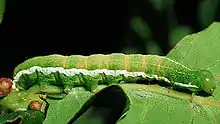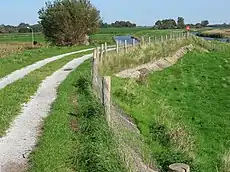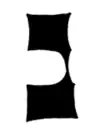Hebrew character
The Hebrew character (Orthosia gothica) is a moth in the family Noctuidae. The species was first described by Carl Linnaeus in his 1758 10th edition of Systema Naturae. It is found throughout Europe.
| Hebrew character | |
|---|---|
.JPG.webp) | |
| Scientific classification | |
| Kingdom: | Animalia |
| Phylum: | Arthropoda |
| Class: | Insecta |
| Order: | Lepidoptera |
| Superfamily: | Noctuoidea |
| Family: | Noctuidae |
| Genus: | Orthosia |
| Species: | O. gothica |
| Binomial name | |
| Orthosia gothica | |
The forewings of this species are greyish to rufous brown. Typically these are marked with a black mark shaped like the Hebrew letter nun (נ). This is similar to the markings of the setaceous Hebrew character although the two species are not closely related. In this species this mark is sometimes split in two or even absent. The hindwings are grey.
Technical description and variation
The wingspan is 30–40 mm. Forewing sandy rufous, black speckled, median area generally deeper rufous: lines browner, forewing purplish red brown; the lines pale, ill defined, except by black spots at costa; the cell black; stigmata pale and large; claviform connected with outer line by a black bar; above which the base of vein 2 is often surrounded with rufous; hindwing fuscous. The size of the orbicular stigma is variable, and the amount and shape of the black filling in of the cell is determined by this variation; — in ab. gothicina H.-Sch. the black markings are replaced by olive brown or rufous; it is a northern form, occurring in Scotland, Scandinavia and Finland, and in the Tarbagatai Mountains; — askoldensis Stgr. [now full species Orthosia askoldensis] from Amurland and Japan has a more violet-grey ground colour; ab. pallida Tutt (22b) has a pale whitish ochreous ground colour; — in rufescens Tutt the reddish tint is predominant: - in rufa Tutt the ground colour is red; — and in brunnea Tutt the rufous tints give place to purplish brown.[1]
Biology
This moth flies at night in March and April (sometimes later) and is attracted to light and various flowers.

The larva are green dotted all over with yellow; dorsal and subdorsal lines yellowish white; spiracular line broad, white, with dark upper edge; head pale green. It feeds on a wide variety of plants (see list below). This species overwinters as a pupa.

Recorded food plants

- Alnus – grey alder
- Betula – birch
- Cannabis – hemp
- Centaurea
- Corylus – common hazel
- Epilobium – rosebay willowherb
- Filipendula ulmaria – meadowsweet
- Hieracium – hawkweed
- Humulus – hop
- Lythrum – purple loosestrife
- Malus – apple
- Polygonatum – Solomon's seal
- Polygonum
- Populus – aspen
- Prunus
- Quercus – oak
- Ranunculus buttercup
- Rhamnus – buckthorn
- Ribes – currant
- Rubus – raspberry
- Rumex
- Salix – willow
- Saxifraga – saxifrage
- Sorbus – rowan
- Tilia - large-leaved lime
- Vaccinium – bilberry
See Robinson, G. S et al.[2]
Notes
- ^ The flight season refers to the British Isles. This may vary in other parts of the range.
References
- Seitz, A. Ed., 1914 Die Großschmetterlinge der Erde, Verlag Alfred Kernen, Stuttgart Band 3: Abt. 1, Die Großschmetterlinge des palaearktischen Faunengebietes, Die palaearktischen eulenartigen Nachtfalter, 1914
- Robinson, Gaden S.; Ackery, Phillip R.; Kitching, Ian J.; Beccaloni, George W.; Hernández, Luis M. (2010). "Search the database - introduction and help". HOSTS - A Database of the World's Lepidopteran Hostplants. Natural History Museum, London.
- Chinery, Michael (1986, reprinted 1991). Collins Guide to the Insects of Britain and Western Europe.
- Skinner, Bernard (1984). The Colour Identification Guide to Moths of the British Isles.
External links
| Wikimedia Commons has media related to Orthosia gothica. |
- Kimber, Ian. "73.249 BF2190 Hebrew Character Orthosia gothica (Linnaeus, 1758)". UKMoths. Retrieved 30 June 2019.
- Savela, Markku. "Orthosia gothica (Linnaeus, 1758)". Lepidoptera and Some Other Life Forms. Retrieved June 30, 2019. Taxonomy
- Lepiforum e.V.
- De Vlinderstichting (in Dutch)
